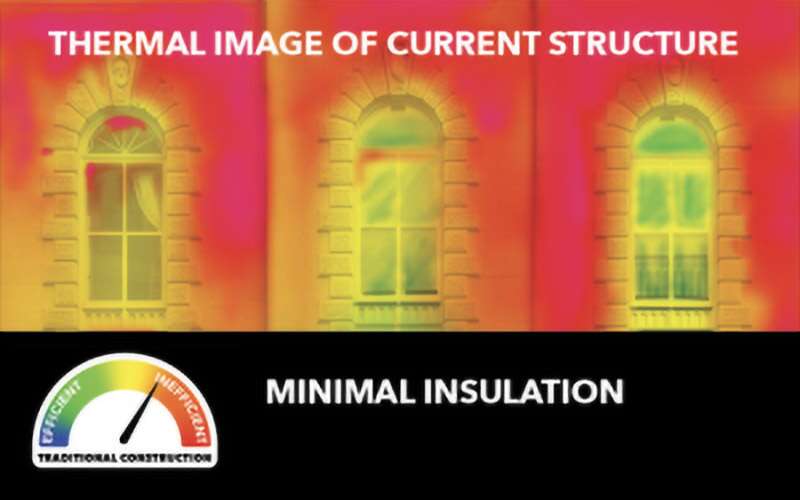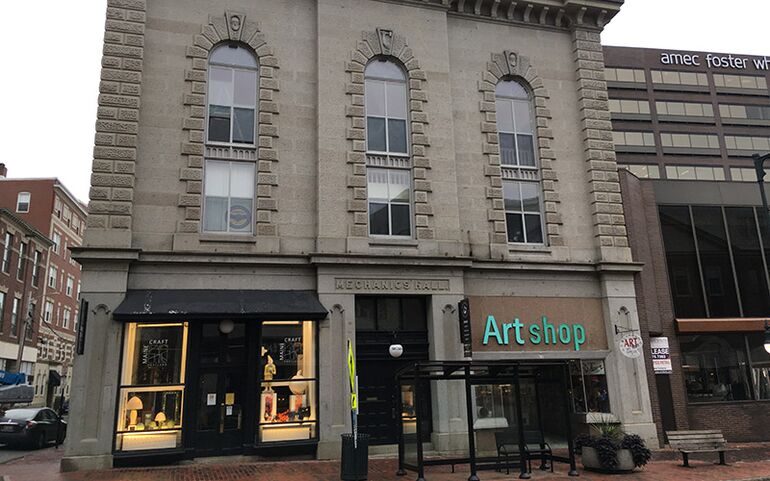
Processing Your Payment
Please do not leave this page until complete. This can take a few moments.
- News
-
Editions
View Digital Editions
Biweekly Issues
- October 20, 2025
- October 6, 2025
- September 22, 2025
- September 8, 2025
- August 25, 2025
- August 11, 2025
- + More
Special Editions
- Lists
- Viewpoints
- Our Events
- Calendar
- Biz Marketplace
Mechanics Hall will be lit up in passivehaus Maine display
 Photo / James McCarthy
Mechanics Hall at 519 Congress St. in Portland will be lit up Friday night with slides showing where the granite building loses heat. It's part of an educational effort by passivhaus Maine to show how passive house construction makes buildings airtight and reduces energy use and carbon emissions.
Photo / James McCarthy
Mechanics Hall at 519 Congress St. in Portland will be lit up Friday night with slides showing where the granite building loses heat. It's part of an educational effort by passivhaus Maine to show how passive house construction makes buildings airtight and reduces energy use and carbon emissions.
Naomi Beal spends a lot of time talking to construction industry professionals as executive director of passivhaus Maine, a nonprofit that supports passive house building in the state.
For a while, she’d been ruminating on an idea to get the concept across to the general public — what if they could display the heat loss in a building on the facade so people could visualize it and better understand what passive house was all about.
When she mentioned the idea to the VIA marketing agency, they embraced it.
The result of almost a year of planning will be on display Friday night, when Mechanics Hall at 519 Congress St. in Portland is lit up with slides showing where the granite building loses heat.
“Most of our work is talking with architects, engineers and builders, really people in high performance construction,” Beal said Wednesday. “This will be a way to really expand that audience, bring it to consumers, rather than professionals.”
Passive house construction makes buildings airtight and reduces energy use and carbon emissions. Much of the state’s certified commercial passive house projects have been affordable housing and academic buildings.
'Fundamentally what passive house is'

The Mechanics Hall projection will feature a 90-second slide show that will play from around dusk until 8 p.m., during the Friday art walk. The images will be projected from the Maine College of Art, across the street.
Via took a thermal image of 159-year-old Mechanics Hall over the winter. The slide that will be projected is a “stylized” version to fully show the heat loss.
“This is very fundamentally what passive house is,” Beal said. “It’s important to see.”
The bright reds and oranges of the image emphasize energy loss in a building and potential cost savings, she said.
Passive house construction, which has strict standards to be certified, is generally new construction, because it require certain types of windows, wall thickness and air circulation machinery. But seeing the leakage from a non-passive-house building is a great illustration of why the construction approach is catching on, she said.
The least amount of heat loss, as shown by the green glow in the image, comes from the windows. The windows in the building were recently restored, said Tom Blackburn, superintendent of Mechanics Hall.
He said that the Maine Charitable Mechanic Association, which owns the building, welcomed the project.
The projection highlights the need for modernization of the building’s heating system, he said, but it’s also “an opportunity to highlight the building and showcase this architectural jewel.”
When built, Mechanics Hall was the tallest building in Portland and was an important part of the city’s history, including boarding Union troops during the Civil War.
Heating 'a huge challenge'
The Maine Charitable Mechanic Association was formed in 1815 to support what was then the city’s creative community: blacksmiths, coopers, carpenters and others. Today, the group supports the “modern makers” movement.
“Our mission is to inspire and enrich the community by promoting ingenuity, creativity, innovation and the diffusion of useful knowledge,” its website says.
Among its tenants is the Maine State Building & Construction Trades Council, which helps with in-kind work, said Blackburn.
The ongoing restoration of the granite and brick building is funded largely by grants and donations.
Modernization of the heating system, pegged at about $300,000, will be done as soon as the hall can raise the $60,000 to $70,000 it will have to pay after energy credits and other grant awards.
“Heating this building is a huge challenge,” he said.
Blackburn said that while an old building like Mechanics Hall can’t be remade to passive house standards, there are are still things that can be done to make it more energy efficient. The window restoration was a start, and he said plans are also to better insulate the roof and attic.
A team effort
On Wednesday, Oct. 10, the hall will host a talk by state historian Earle Shettleworth about Thomas Sparrow, the state’s first professional architect and the building’s designer, as a fundraiser for upcoming projects.
The hall will also be the site of the 2018 Passive House Fall Forum on Nov. 1 and 2, which will focus on both residential and academic passive house construction.
Beal said the projection is a team effort that not only includes the hall’s organization, but Maine School of Art, VIA and Headlight Audio Visual, the company that’s projecting the image.
“It’s taken a lot of time and equipment to make this work,” she said.
Still, if Friday’s projection goes well, she’d like to see it done again, possibly with a newer conventional construction building, maybe even contrasted with one built to passive house standards.
“It’s a great opportunity for people to see what [passive house construction] is really all about,” she said.
Mainebiz web partners

The Giving Guide
The Giving Guide helps nonprofits have the opportunity to showcase and differentiate their organizations so that businesses better understand how they can contribute to a nonprofit’s mission and work.
Learn More
Work for ME
Work for ME is a workforce development tool to help Maine’s employers target Maine’s emerging workforce. Work for ME highlights each industry, its impact on Maine’s economy, the jobs available to entry-level workers, the training and education needed to get a career started.
Learn More
Groundbreaking Maine
Whether you’re a developer, financer, architect, or industry enthusiast, Groundbreaking Maine is crafted to be your go-to source for valuable insights in Maine’s real estate and construction community.
Learn more-
The Giving Guide
The Giving Guide helps nonprofits have the opportunity to showcase and differentiate their organizations so that businesses better understand how they can contribute to a nonprofit’s mission and work.
-
Work for ME
Work for ME is a workforce development tool to help Maine’s employers target Maine’s emerging workforce. Work for ME highlights each industry, its impact on Maine’s economy, the jobs available to entry-level workers, the training and education needed to get a career started.
-
Groundbreaking Maine
Whether you’re a developer, financer, architect, or industry enthusiast, Groundbreaking Maine is crafted to be your go-to source for valuable insights in Maine’s real estate and construction community.
ABOUT
NEW ENGLAND BUSINESS MEDIA SITES
No articles left
Get access now
In order to use this feature, we need some information from you. You can also login or register for a free account.
By clicking submit you are agreeing to our cookie usage and Privacy Policy
Already have an account? Login
Already have an account? Login
Want to create an account? Register
Get access now
In order to use this feature, we need some information from you. You can also login or register for a free account.
By clicking submit you are agreeing to our cookie usage and Privacy Policy
Already have an account? Login
Already have an account? Login
Want to create an account? Register







Comments